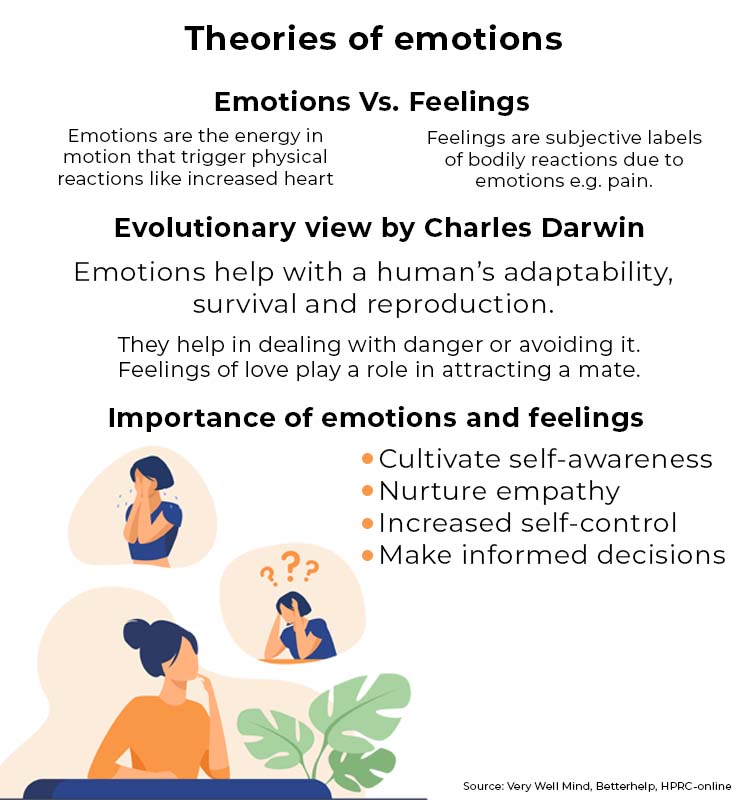Humans naturally gravitate towards pleasurable things and avoid what is painful even if it is emotions. So, it is crucial to understand that for answering big questions of life, one has to develop emotional awareness. One best way is to recognize the signals sent by our basic emotions.
Emotions vs. Feelings
In daily life, these two words are used interchangeably. However, there are differences between them. Emotions are neurochemical changes in the brain and body, for instance, a racing heart or shallow breathing. Whereas feelings are subjective perceptions of emotions, such as pain and hunger. Emotions are a part of human DNA that ensures survival and mating; some basic emotions include joy, anger, disgust, fear, sadness, and surprise. Additionally, they are experienced unconsciously, however, feelings make themselves known at a conscious level.
Let’s explore more and understand this better so that it helps bring a positive impact in life.
Evolutionary Perspective
From the perspective of Charles Darwin, humans developed emotions because they made adaptability, survival, and reproduction possible. For example, feelings of affection and love motivate one to find a partner whereas fear motivates the individual to avoid danger or prepare for it. Coming towards the survival value of emotions, whenever there is a change in the environment they help in reacting quickly. Having emotional intelligence also helps in responding to the needs of others. For instance, if someone makes a sad face, it signals the need for comfort and healing.
Theories of Emotions
There are three broad categories of emotions – physiological, neurological, and cognitive. The physiological perspective explains that bodily reactions lead to emotions. The neurological perspective explains that the changes in the brain produce emotions and finally, the cognitive perspective highlights the importance of thoughts and perceptions for the production of emotions.
Lazarus/ Cognitive Appraisal theory
According to this perspective, thinking comes first before the flow of emotions in the body. For example, seeing a snake in the environment triggers a thought about danger alert, that leads to a bodily reaction of fear – dry mouth, sweating, shallow breathing, increased heart rate, and nausea.
Canon-Bard theory
From the perspective of Canon and Bard, bodily reactions and mental experience of emotion take place simultaneously so there is no causal link between them. For example, a student who got a good score on his exams will experience feelings of joy as well as physical signs of joy like- dilated pupils, sweating, smiling face, blushing, and increased blinking, whereas, during a public speaking event, the speaker can feel anxious and its physical signs at the same time.
James-Lange theory
This theory comes under the physiological category of theories of emotions. So, according to this perspective, emotions are the consequence of the interpretation of bodily reactions. It means that physical reaction comes first and then the perception of it. The perception tells which feeling to experience. For example, a person sees a cute unicorn on TV, they start to pay more attention, their pupils dilate and they start sweating a little. All of these bodily reactions when interpreted as excitement lead to feelings of joy. In other words, the person experiences pupil dilation, and a little bit of increase in heart rate along with other signs, therefore, the individual is happy.
Schacter-Singer theory
This perspective is also known as the two-factor theory of emotions. In addition to it, this theory is influenced by two other theories of emotions by James-Lange and Canon-Bard. The crucial aspects in Schacter-Singer’s perspective are the cognitive aspect and the environmental stimulus. In line with the Canon-Bard theory, this theory also supports that physical reactions to a stimulus can mean different emotions. Put differently, the body produces a reaction due to a stimulus which is then perceived as a certain emotion.
For example, an employee who got a promotion at work felt excited which he labeled as joy or surprise whereas when a man on a date felt excited, he interpreted it as love.
Facial Feedback theory
Charles Darwin and William James observed that an individual’s facial expressions have an impact on emotions and vice versa. This is because facial muscles are linked with emotional arousal. For example, at a party when a person smiles forcibly, they experience feelings of joy as compared to individuals who spent time with gloomy facial expressions. Another example is, having sad face results in a low mood, lethargy, and physical pain.
Somatic Feedback theory
According to this perspective, each emotion has a unique set of physical signs. For example, there is one set of physical symptoms for sadness, anger, fear, joy, surprise, and love. Hence, the connection between mind and body is vital for emotional understanding.
Importance of theories of emotions
It is easy to be aware of one’s feelings but difficult to develop insight into emotions. Having a comprehensive understanding of both of them helps cultivate self-awareness, emotional intelligence, empathy, better connection with others, better self-control, and much more. For medical and research purposes, physical signs play an important role in quantifying emotions as they can be measured using different machines like electrocardiography (ECG) or sphygmomanometer (a tool for checking blood pressure).
To elaborate further, having insight into both emotions and feelings helps in successfully navigating the world. It means that an individual can find out the cause of them, think better, and then make informed decisions. Many people are afraid of experiencing their emotions so they avoid or suppress them, which is maladaptive. To them, it is important to know that emotions are a kind of information that can empower a person if utilized correctly. For example, when a grandfather plays with his grandchildren, he will experience joy and love that fulfill his need for connection and satisfaction in life. Other than that, when an individual bites into a rotten fruit, she experiences disgust that forces her to throw up. This saves her from food poisoning and ensures her survival.
Wrap up
In conclusion, emotions play an important role in how a person behaves. The flow of strong emotions suggests actions for matters and beats avoidance. Different theories try to explain emotions in different ways and try to minimize the mystery around them. The aspect of scientific research has not been touched on in this article. Looking at the scientific evidence can help in analyzing the theories for better understanding. Many experts from different fields have conducted numerous researches like social psychology, cognitive domain, neuroscience, anthropology, and ethology. So, all of this effort has made the study of emotions fascinating.





